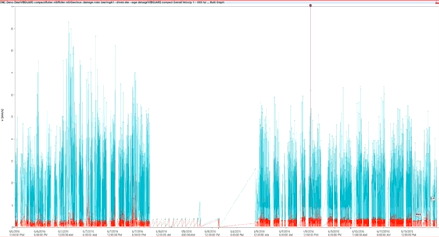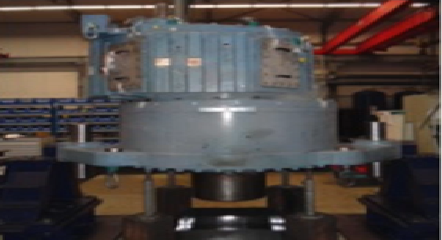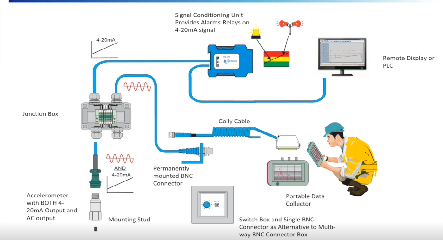Today we’re going to be looking at one in a series of secrets of spectrum analysis: the importance of “accurate” amplitudes. When thinking about the term “accurate” in the traditional sense, that’s an elusive concept when it comes to vibration amplitudes because there’s a number of factors that affect the exact number that is calculated as the vibration amplitude. There is something that is referred to as accuracy in terms of amplitudes, but that is not what we are looking at in this case, so we’re going to look at those factors and the actual true term that should be used when we refer to “accuracy” in terms of amplitudes.
Here we see a spectrum, the most commonly used and probably the most effective plot that we have to analyze data. Of course, there are trend plots and time waveform plots; all of them have the capability of setting up alarms, so you can see the orange and yellow bars and you can see the word “exceeded”: all of those are alarms that have been triggered, and they are all based on amplitude. Once the alarms are triggered, then we are triggered into action. We dive into the data, we look more deeply, we spend the time, and we try to figure out what’s going on in the machine. That will allow us to react accordingly. So obviously, the amplitude levels in regard to the alarm levels are an important factor to consider. One of the things that will help to determine what those alarm levels are is whether we set up our database to display those peaks and RMS values or peak values. There is a fixed mathematical relationship between the two. You can’t switch back and forth. There is no right or wrong way as long as you don’t do that. As long as you pick one and stick with it, you can adjust everything accordingly, but just don’t switch back and forth. But this is one of the factors we have to consider when looking at the so-called accuracy of amplitudes.
What about the attachment method? This is more of a hidden issue. We don’t necessarily know how well-attached the sensor may be. Here we see an adhesively mounted sensor with a frequency of 1135 Hz—that’s where the red line is—and an amplitude of a little over 2.5 mm/s. Compare that to a two-pole magnet at the same frequency and at the same location, at just under 3 mm/s—a difference of about 16%. And then what about the stinger probe? Well, that’s pretty awful—more than double either of the other two amplitudes and, even more strikingly, look at this peak out here, which is about eight or nine times the equivalent peak on the other two plots. That is strictly a function of the natural frequency of the probe. It is resonating, it is driving up the amplitudes artificially and, therefore, it could lead you to an expensive mistake in your diagnosis.
What about aligning or non-aligning frequencies? What we mean by an aligning frequency is that the forcing frequency the machine is generating just happens to fall exactly on a line of resolution—in this case, 16 Hz, the location of the red line. You’ll see the time waveform begins and ends at exactly the same point in that time sample. If, however, we start to move this frequency away from the line of resolution and start moving it toward the next line of resolution, you can see it has a rather dramatic effect on the amplitude level. That is with no window—you can lose up to 35% of the amplitude value. A Hanning window helps with the problem, but it doesn’t fix it. You can see here that you’re still losing amplitude and, of course, the worst-case scenario is about a 15% decrease in amplitude values.
Of course, the sensor location makes a huge difference. We know the transmission path is critically important. Frequency response is an important issue, but transmission path is, of course, the path the vibration takes to reach the sensor. The vibration is originating here at the bearing. This would be an ideal location, but because of safety issues (which it looks like we may have), maybe we’re here on the bell end of the motor, maybe we’re here on the stator end of the motor, maybe we’re even straddling a couple of fins because there’s nowhere good to put it—all of that is going to have an impact on how well the vibration signals reach the sensor, and that will affect the amplitude levels. So we have to be careful to get right on the bearing.
The bottom line is, consistency is the most important aspect in terms of the accuracy of amplitudes, and the word we use for consistency is, of course, repeatability. If we have a high level of repeatability, meaning the same sensor, the same attachment mechanism, the same location, etc., then we can trust that whatever changes we see in our data actually mean something legitimate is changing on the machine, and we can proceed from there.
What is it we mean by accuracy? The real term is “frequency response.” That is defined as the ability to accurately measure high frequencies. High frequencies do not travel well, they do not jump across joined surfaces, and there are a number of things that can affect them. So basically, that is the real definition when we use the term accuracy; that’s what we’re referring to.






